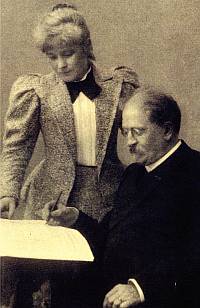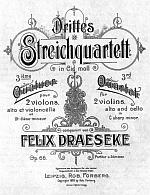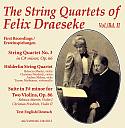FELIX DRAESEKE:
String Quartet No. 3 in C# minor, Op. 66
|
Program notes prepared by Alan Krueck for the premiere recording of Draeseke's String Quartets for AK/Coburg Recordings. |
|
On the 16th of May, 1894 at the age of 58, Felix Draeseke married his former pupil Frida Neuhaus (1859-1942), 24 years his junior. The marriage was legendary in its happiness. During its first year, Draeseke worked primarily on a single work, his comic opera Fischer und Kalif, but he also began seriously sketching his Mysterium Christus. It was only in September 1895 that Draeseke completed his first instrumental work since the Concerning this string quartet in C# minor Erich Roeder observes:
Roeder says more about the work than he had been aware of in the NS-period, since the observation could be applied to a Schoenberg or a Bartok from our historical distance today, though Roeder more likely had Max Reger or Hans Pfitzner in mind – though certainly not the politically disdained Paul Hindemith. Nevertheless, this appreciation of Draeseke’s string quartet is fitting and its phrasing just. It serves no purpose here to attempt an extended analysis of all the movements of the C# minor string quartet. Although the design of the movements is relatively apparent, the technical details are so refined, that any attempt at detailing them would go beyond the limits of this booklet. String Quartet No. 3 in C# minor, Op. 66
Indicated as Andante elegiaco, the first movement of the third string quartet begins in a manner similar to that in the second string quartet, though here the exposition of the first major idea occurs high in the first violin, instead of in the cello as in the second quartet. Lyrically attractive it is once again repeated in the entire ensemble and a second melody (in D major) is brought in. Both themes are treated in a contrapuntally dramatic manner and with grippingly energetic creativity the elegiac concept is broadened magnificently through the following sonata-allegro sections toward a broadly euphonious conclusion. Allegro spumante is perfect characterization for the effervescent scherzo in C# minor with its endearing harmonic turns in the instrumental interplay. Attractive and appealing is the Trio, the development of which - according to Erich Roeder - recalls the third movement of Draeseke’s orchestral Serenade in D major, Op. 30. The third movement Adagio non tanto, molto espressivo astounds the listener with Draeseke’s richly inventive ability in melodic development. Beginning quietly within an ambience of almost four octaves for the ensemble, Draeseke weaves a masterful pattern of unendliche Melodie from the constant and independent instrumental voices. Length is calculated perfectly, the experience unforgettable. A totally different mood is awakened by the following intermezzo (allegretto grazioso, D major) which, with its indigenous harmonic contrasts, presents itself as cheerful and smart. The beginning part is contrasted with a steadily pulsing G minor trio and then da capo reigns. After such refreshing spirit from the Intermezzo Draeseke presents a finale (allegro risoluto, C# minor, 4/4) filled with Sturm und Drang. The rhythmically assertive unisono- beginning stands in complete contrast to the other movements. Virtuoso combination of sonata and rondo form proceeds with excitement never slackening until an unexpected fermata at the conclusion of a radiant fugato brings sudden quiet., after which a concluding portion introduced pizzicato returns the main theme of the first movement and contrapuntally proceeds to the return of the stormy unisono-beginning, which also represents the coda, and all concludes in succinct brilliance. With the recording of this third string quartet, the entire series of Felix Draeseke’s three string quartets is complete and available for the first time in public recorded form and herewith presented. In conclusion, of this undertaking we offer a quotation from Rainer Cadenbach’s essay in the fifth volume of the publications of the International Draeseke Society: “The string quartets of Felix Draeseke reflect “formal fulfillment” in the extreme, but nevertheless also represent the highly individual and, without any hesitation in judgment, progressive examples in their category.” |
|
|
|
Am 16. Mai 1894 im Alter von 58 Jahren heiratete Felix Draeseke seine ihm 24 Jahre jüngere ehemalige Studentin Frida Neuhaus (1859-1942): eine legendär glückliche Ehe. Im ersten Jahr dieser Ehe arbeitete Draeseke hauptsächlich an einem einzigen Werk, der komischen Oper Fischer und Kalif, aber begann auch ernsthafte Vorwürfe für das Mysterium Christus. Erst im September 1895 vollendete Draeseke sein erstes Instrumentalwerk seit der Heirat: Über dieses Streichquartett schreibt Erich Roeder:
Vom heutigen Standpunkt angeschaut sagt hier Roeder mehr über das Werk als er damals in der NS-Zeit wohl schätzte, da das obige Paragraph sich wohl auf einen Schönberg oder einen Bartok angebracht werden könnte, wenn damals allein Max Reger oder Hans Pfitzner im Sinne waren, deutet das indirekt auch auf einen im Dritten Reich unbeliebten Paul Hindemith. Trotzdem ist Roeders Schätzung des Quartetts am Platz und seine Worte demgemäß gerecht. Streichquartett Nr. 3 in Cis-moll, Op.66
Es nützt hier wenig eine eingehende Analyse aller Sätze des Cis-moll Streichquartetts zu unternehmenen. Obwohl die Auslegung aller Sätze relativ eindeutig ist, sind die technischen Sachen darin so deratig raffiniert, daß Überlegung und detailliete Beschreibungen davon den Rahmen dieses CD-Heftes sprengen würden. Der mit Andantino elegiaco bezeichtnete erste Satz (Cis-moll, 4/4) fängt in auffallender gleicher Weise an, wie der este Satz im zweiten Streichquartett, aber hier nur mit Expositionslage des ersten Hauptgedankens hoch in der ersten Violine, statt im Cello wie im zweiten Quartett. Wiedermals schon lyrisch attraktiv und im ganzen Ensemble wiederholt folgt bald ein in D-dur zweites Thema. Die beiden Themen werden in kontrapunktisch dramatischer Weise bearbeitet und und mit ergreifender Entwicklungsenergie wird das Elegische prachtvoll durch die folgenden Satzteile ausgestattet bis zu klangbreitem Ausgang. Allegro spumante deutet ganz richtig auf das hervorsprudelnde Scherzo (Cis-moll. 6-8) mit dessen köstlich harmonischen Wendungen des Zusammenspiels. Ganz unkompliziert und anziehend ist das Trio, dessen Entwicklung Erich Roeder nach an den dritten Satz in Draesekes Serenade in D-dur für Orchester Op. 49 erinnert. Im dritten Satz Adagio non tanto, molto espressivo (B-dur, 4/4) muß man vor Draesekes erfindungsreichen melodischen Entwicklungsfähigkeiten tatsächlich staunen. Leise beginnend mit einer Klangbreite von beinahe vier Oktaven im Ensemble webt Draeseke in dauernder Unabhängigkeit die vier Stimmen in einer meisterhaften Darstellung von unendlicher Melodie. Die Dauer ist perfekt gemessen, das Erlebnis unvergeßlich. Eine ganz andere Stimmung bringt das darauffolgende Intermezzo (Allegro grazioso, D-dur, 3/4), das fesch und ermunternd in den eigenen harmonischen Kontrasten wirkt. Dem Anfangsteil begegnet ein durchaus gerade pulsierendes B-dur Trio und da capo herrscht. Nach dem erfrischendem Geist des Intermezzos bringt Draeseke ein Finale (Allegro risoluto, Cis-moll, 4/4) voll Sturm und Drang. Der rhythmisch starke Unisono-Beginn steht in vollem Kontrast zu den anderen Sätzen. Virtuos verläuft die Mischung von Sonatensatz und Rondoform und die Aufregung hört nicht auf, bis eine Fermata am Ende eines funkelnden Fugatos eine plötzlich Ruhe einsetzt, wonach pizzicato ein Schlußteil das Haupthema von dem ersten Satz zurückbringt und sie kontrapunktisch bis zur Wiederkehr des stürmischen Unisono-Anfangs führt, welche das Coda darstellt und alles knapp und brillant abschließt. Mit Einspielung von diesem dritten Streichquartett ist die ganze Reihe von den Streichquartetten Felix Draesekes zum ersten Mal in öffentlichem Aufnahmeformat abgeschlossen und angeboten. Mit einem Zitat von Rainer Cadenbachs Aufsatz im 5. Band der Veröffentlichungen der Internationalen Draeseke Gesellschaft schenken wir zum Schluß ein Gutachten: „In ihrer äußerst reflektierten „Formerfüllung“ jedoch stellen Draesekes Streichquartette höchst eigenständige und, so ist ohne Einschränkung zu betonen, fortschrittliche Exempla der Gattung da.“ © Alan H. Krueck |
| Draeseke's Third String Quartet on CD: | |
"The Hölderlin String Quartet... sound absolutely terrific, with a wide range of expression, vitality, and sensitive ensemble playing" from a review at classical.net |
|
[Chamber Music] [Orchestral Music] [Keyboard Music] [Listen: mp3] [Top]
© All contents copyright by the International Draeseke Society
 wedding: the String Quartet No. 3 in C# minor, Op.66. As previously mentioned, Draeseke himself confessed that the work was the result of lifelong admiration of Beethoven’s String Quartet in C# minor, Op. 131 (Nr.14). But Draeseke’s work is not imitation. The quartet is a masterful example of Draeseke’s creative powers within the form, one which he had not touched for nearly ten years, but not only that, for in its depth and beauty one may see in it a mirror of satisfaction with his marriage. On the other hand, in the Lebenserinnerungen one encounters Draeseke’s loving but strict admonition to his wife shortly after finishing this quartet: “… on October 12 [1895] I was working on a reasonably unimportant item for which I had found a promising motive. Before I could have finished, my dear Fritzle, who had never observed the act of creation, intervened like a thought poacher and ruined the entire mood. For that she received a well deserved sermon, which must have impressed her greatly, for she has never disturbed me since while working.”
wedding: the String Quartet No. 3 in C# minor, Op.66. As previously mentioned, Draeseke himself confessed that the work was the result of lifelong admiration of Beethoven’s String Quartet in C# minor, Op. 131 (Nr.14). But Draeseke’s work is not imitation. The quartet is a masterful example of Draeseke’s creative powers within the form, one which he had not touched for nearly ten years, but not only that, for in its depth and beauty one may see in it a mirror of satisfaction with his marriage. On the other hand, in the Lebenserinnerungen one encounters Draeseke’s loving but strict admonition to his wife shortly after finishing this quartet: “… on October 12 [1895] I was working on a reasonably unimportant item for which I had found a promising motive. Before I could have finished, my dear Fritzle, who had never observed the act of creation, intervened like a thought poacher and ruined the entire mood. For that she received a well deserved sermon, which must have impressed her greatly, for she has never disturbed me since while working.” das Streichquartett Nr. 3 in Cis-moll, Op. 66.Wie im ersten Band schon angedeutet ist das Werk von Draeseke selbst als Ergebnis seiner lebenslangen Schätzung von und Begeisterung für Beethovens Streichquartett in Cis-moll, Op. 131 (Nr.14) zugegeben. Aber blosse Nachahmung ist Draesekes Opus nicht. Das Quartett ist ein meisterhaftes Beispiel der Schöpferkraft Draesekes in einer Gattung, welche er fast 10 Jahre lang nicht berührte und wohl dessen Tiefe und Schönheit seinen glücklichen Ehestand spiegelt, obwohl dem entgegen liest man in den Lebenserinnerungen seine liebvolle aber strenge Lehre an seine Frau als er kurz nach Beenden dieses Streichquartettes lieferte: „... Am 12. Oktober [1895] begann ich an einer ziemlich bedeutungslosen Stelle, für die ich ein zusagendes Motiv gefunden. Doch hätte ich beinahe gleich wieder aufgehört, da meine liebes Fritzle, die das Enstehen einer Schöpfung wohl nicht erlebt hatte, mir als Reminiscenzenjägerin dazwischen trat und die ganze Stimmung verdarb. Hierfür bekam sie eine ganz gehörige Predigt zu vernehmen, die sehr grossen Eindruck gemacht haben muss, denn beim Schaffen hat sie mich nie wieder gestört.“
das Streichquartett Nr. 3 in Cis-moll, Op. 66.Wie im ersten Band schon angedeutet ist das Werk von Draeseke selbst als Ergebnis seiner lebenslangen Schätzung von und Begeisterung für Beethovens Streichquartett in Cis-moll, Op. 131 (Nr.14) zugegeben. Aber blosse Nachahmung ist Draesekes Opus nicht. Das Quartett ist ein meisterhaftes Beispiel der Schöpferkraft Draesekes in einer Gattung, welche er fast 10 Jahre lang nicht berührte und wohl dessen Tiefe und Schönheit seinen glücklichen Ehestand spiegelt, obwohl dem entgegen liest man in den Lebenserinnerungen seine liebvolle aber strenge Lehre an seine Frau als er kurz nach Beenden dieses Streichquartettes lieferte: „... Am 12. Oktober [1895] begann ich an einer ziemlich bedeutungslosen Stelle, für die ich ein zusagendes Motiv gefunden. Doch hätte ich beinahe gleich wieder aufgehört, da meine liebes Fritzle, die das Enstehen einer Schöpfung wohl nicht erlebt hatte, mir als Reminiscenzenjägerin dazwischen trat und die ganze Stimmung verdarb. Hierfür bekam sie eine ganz gehörige Predigt zu vernehmen, die sehr grossen Eindruck gemacht haben muss, denn beim Schaffen hat sie mich nie wieder gestört.“ 